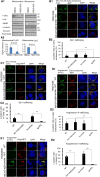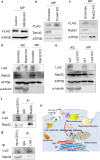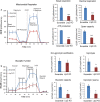Megalin mediates plasma membrane to mitochondria cross-talk and regulates mitochondrial metabolism
- PMID: 29916093
- PMCID: PMC11105752
- DOI: 10.1007/s00018-018-2847-3
Megalin mediates plasma membrane to mitochondria cross-talk and regulates mitochondrial metabolism
Abstract
Mitochondrial intracrines are extracellular signaling proteins, targeted to the mitochondria. The pathway for mitochondrial targeting of mitochondrial intracrines and actions in the mitochondria remains unknown. Megalin/LRP2 mediates the uptake of vitamins and proteins, and is critical for clearance of amyloid-β protein from the brain. Megalin mutations underlie the pathogenesis of Donnai-Barrow and Lowe syndromes, characterized by brain defects and kidney dysfunction; megalin was not previously known to reside in the mitochondria. Here, we show megalin is present in the mitochondria and associates with mitochondrial anti-oxidant proteins SIRT3 and stanniocalcin-1 (STC1). Megalin shuttles extracellularly-applied STC1, angiotensin II and TGF-β to the mitochondria through the retrograde early endosome-to-Golgi transport pathway and Rab32. Megalin knockout in cultured cells impairs glycolytic and respiratory capacities. Thus, megalin is critical for mitochondrial biology; mitochondrial intracrine signaling is a continuum of the retrograde early endosome-to-Golgi-Rab32 pathway and defects in this pathway may underlie disease processes in many systems.
Keywords: ApoE; OCRL1; PIKfyve; Proteinuria; Sonic hedgehog; Vitamin D.
Conflict of interest statement
No financial interests to disclose.
Figures









Similar articles
-
Cubilin-, megalin-, and Dab2-dependent transcription revealed by CRISPR/Cas9 knockout in kidney proximal tubule cells.Am J Physiol Renal Physiol. 2022 Jan 1;322(1):F14-F26. doi: 10.1152/ajprenal.00259.2021. Epub 2021 Nov 8. Am J Physiol Renal Physiol. 2022. PMID: 34747197 Free PMC article.
-
Megalin-deficiency causes high myopia, retinal pigment epithelium-macromelanosomes and abnormal development of the ciliary body in mice.Cell Tissue Res. 2014 Oct;358(1):99-107. doi: 10.1007/s00441-014-1919-4. Epub 2014 Jul 1. Cell Tissue Res. 2014. PMID: 24980834 Free PMC article.
-
Variable expression pattern in Donnai-Barrow syndrome: Report of two novel LRP2 mutations and review of the literature.Eur J Med Genet. 2015 May;58(5):293-9. doi: 10.1016/j.ejmg.2014.12.008. Epub 2015 Feb 13. Eur J Med Genet. 2015. PMID: 25682901 Review.
-
Megalin-Mediated Trafficking of Mitochondrial Intracrines: Relevance to Signaling and Metabolism.J Cell Immunol. 2021 Nov 23;3(6):364-369. J Cell Immunol. 2021. PMID: 35098216 Free PMC article.
-
Megalin and the neurodevelopmental biology of sonic hedgehog and retinol.J Cell Sci. 2003 Mar 15;116(Pt 6):955-60. doi: 10.1242/jcs.00313. J Cell Sci. 2003. PMID: 12584240 Review.
Cited by
-
Lipocalin-2 deficiency may predispose to the progression of spontaneous age-related adiposity in mice.Sci Rep. 2020 Sep 3;10(1):14589. doi: 10.1038/s41598-020-71249-7. Sci Rep. 2020. PMID: 32883997 Free PMC article.
-
The genetic vulnerability to cisplatin ototoxicity: a systematic review.Sci Rep. 2019 Mar 5;9(1):3455. doi: 10.1038/s41598-019-40138-z. Sci Rep. 2019. PMID: 30837596 Free PMC article.
-
Integrative Clinical and DNA Methylation Analyses in a Population-Based Cohort Identifies CDH17 and LRP2 as Risk Recurrence Factors in Stage II Colon Cancer.Cancers (Basel). 2022 Dec 27;15(1):158. doi: 10.3390/cancers15010158. Cancers (Basel). 2022. PMID: 36612154 Free PMC article.
-
GRKs and β-Arrestins: "Gatekeepers" of Mitochondrial Function in the Failing Heart.Front Pharmacol. 2019 Feb 12;10:64. doi: 10.3389/fphar.2019.00064. eCollection 2019. Front Pharmacol. 2019. PMID: 30809146 Free PMC article. Review.
-
The relationship between amyloid-beta and brain capillary endothelial cells in Alzheimer's disease.Neural Regen Res. 2022 Nov;17(11):2355-2363. doi: 10.4103/1673-5374.335829. Neural Regen Res. 2022. PMID: 35535871 Free PMC article. Review.
References
-
- Birn H, Verroust PJ, Nexo E, Hager H, Jacobsen C, Christensen EI, Moestrup SK. Characterization of an epithelial approximately 460-kDa protein that facilitates endocytosis of intrinsic factor-vitamin B12 and binds receptor-associated protein. J Biol Chem. 1997;272:26497–26504. doi: 10.1074/jbc.272.42.26497. - DOI - PubMed
MeSH terms
Substances
Supplementary concepts
Grants and funding
LinkOut - more resources
Full Text Sources
Other Literature Sources
Research Materials
Miscellaneous

